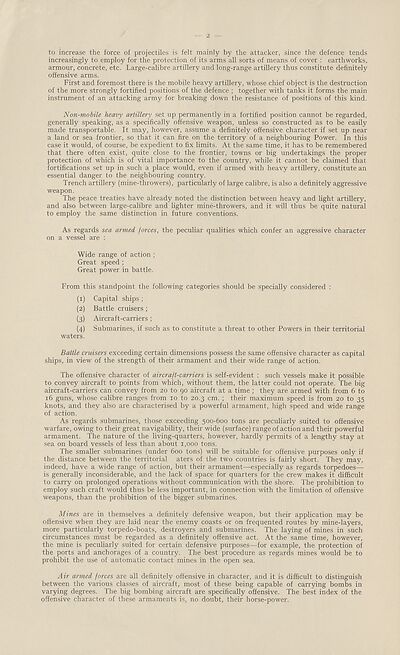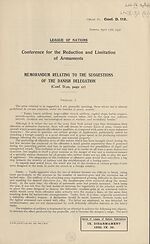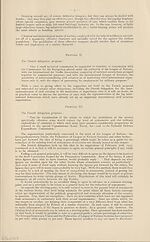Armament > Memorandum relating to the suggestions of the Danish delegation (Conf. D. 99, page 51)
(2)
Download files
Complete book:
Individual page:
Thumbnail gallery: Grid view | List view

— 2
to increase the force of projectiles is felt mainly by the attacker, since the defence tends
increasingly to employ for the protection of its arms all sorts of means of cover : earthworks,
armour, concrete, etc. Large-calibre artillery and long-range artillery thus constitute definitely
offensive arms.
First and foremost there is the mobile heavy artillery, whose chief object is the destruction
of the more strongly fortified positions of the defence ; together with tanks it forms the main
instrument of an attacking army for breaking down the resistance of positions of this kind.
Non-mobile heavy artillery set up permanently in a fortified position cannot be regarded,
generally speaking, as a specifically offensive weapon, unless so constructed as to be easily
made transportable. It may, however, assume a definitely offensive character if set up near
a land or sea frontier, so that it can hre on the territory of a neighbouring Power. In this
case it would, of course, be expedient to fix limits. At the same time, it has to be remembered
that there often exist, quite close to the frontier, towns or big undertakings the proper
protection of which is of vital importance to the country, while it cannot be claimed that
fortifications set up in such a place would, even if armed with heavy artillery, constitute an
essential danger to the neighbouring country.
Trench artillery (mine-throwers), particularly of large calibre, is also a definitely aggressive
weapon.
The peace treaties have already noted the distinction between heavy and light artillery,
and also between large-calibre and lighter mine-throwers, and it will thus be quite natural
to employ the same distinction in future conventions.
As regards sea armed forces, the peculiar qualities which confer an aggressive character
on a vessel are :
Wide range of action ;
Great speed ;
Great power in battle.
From this standpoint the following categories should be specially considered :
(1) Capital ships ;
(2) Battle cruisers ;
(3) Aircraft-carriers;
(4) Submarines, if such as to constitute a threat to other Powers in their territorial
waters.
Battle cruisers exceeding certain dimensions possess the same offensive character as capital
ships, in view of the strength of their armament and their wide range of action.
The offensive character of aircraft-carriers is self-evident : such vessels make it possible
to convey aircraft to points from which, without them, the latter could not operate. The big
aircraft-carriers can convey from 20 to 90 aircraft at a time ; they are armed with from 6 to
16 guns, whose calibre ranges from 10 to 20.3 cm. ; their maximum speed is from 20 to 35
knots, and they also are characterised by a powerful armament, high speed and wide range
of action.
As regards submarines, those exceeding 500-600 tons are peculiarly suited to offensive
warfare, owing to their great navigability, their wide (surface) range of action and their powerful
armament. The nature of the living-quarters, however, hardly permits of a lengthy stay at
sea on board vessels of less than about 1,000 tons.
The smaller submarines (under 600 tons) will be suitable for offensive purposes only if
the distance between the territorial aters of the two countries is fairly short. They may,
indeed, have a wide range of action, but their armament—especially as regards torpedoes—
is generally inconsiderable, and the lack of space for quarters for the crew makes it difficult
to carry on prolonged operations without communication with the shore. The prohibition to
employ such craft would thus be less important, in connection with the limitation of offensive
weapons, than the prohibition of the bigger submarines.
Mines are in themselves a definitely defensive weapon, but their application may be
offensive when they are laid near the enemy coasts or on frequented routes by mine-layers,
more particularly torpedo-boats, destroyers and submarines. The laying of mines in such
circumstances must be regarded as a definitely offensive act. At the same time, however,
the mine is peculiarly suited for certain defensive purposes—for example, the protection of
the ports and anchorages of a country. The best procedure as regards mines would be to
prohibit the use of automatic contact mines in the open sea.
Air armed forces are all definitely offensive in character, and it is difficult to distinguish
between the various classes of aircraft, most of these being capable of carrying bombs in
varying degrees. The big bombing aircraft are specifically offensive. The best index of the
offensive character of these armaments is, no doubt, their horse-power.
to increase the force of projectiles is felt mainly by the attacker, since the defence tends
increasingly to employ for the protection of its arms all sorts of means of cover : earthworks,
armour, concrete, etc. Large-calibre artillery and long-range artillery thus constitute definitely
offensive arms.
First and foremost there is the mobile heavy artillery, whose chief object is the destruction
of the more strongly fortified positions of the defence ; together with tanks it forms the main
instrument of an attacking army for breaking down the resistance of positions of this kind.
Non-mobile heavy artillery set up permanently in a fortified position cannot be regarded,
generally speaking, as a specifically offensive weapon, unless so constructed as to be easily
made transportable. It may, however, assume a definitely offensive character if set up near
a land or sea frontier, so that it can hre on the territory of a neighbouring Power. In this
case it would, of course, be expedient to fix limits. At the same time, it has to be remembered
that there often exist, quite close to the frontier, towns or big undertakings the proper
protection of which is of vital importance to the country, while it cannot be claimed that
fortifications set up in such a place would, even if armed with heavy artillery, constitute an
essential danger to the neighbouring country.
Trench artillery (mine-throwers), particularly of large calibre, is also a definitely aggressive
weapon.
The peace treaties have already noted the distinction between heavy and light artillery,
and also between large-calibre and lighter mine-throwers, and it will thus be quite natural
to employ the same distinction in future conventions.
As regards sea armed forces, the peculiar qualities which confer an aggressive character
on a vessel are :
Wide range of action ;
Great speed ;
Great power in battle.
From this standpoint the following categories should be specially considered :
(1) Capital ships ;
(2) Battle cruisers ;
(3) Aircraft-carriers;
(4) Submarines, if such as to constitute a threat to other Powers in their territorial
waters.
Battle cruisers exceeding certain dimensions possess the same offensive character as capital
ships, in view of the strength of their armament and their wide range of action.
The offensive character of aircraft-carriers is self-evident : such vessels make it possible
to convey aircraft to points from which, without them, the latter could not operate. The big
aircraft-carriers can convey from 20 to 90 aircraft at a time ; they are armed with from 6 to
16 guns, whose calibre ranges from 10 to 20.3 cm. ; their maximum speed is from 20 to 35
knots, and they also are characterised by a powerful armament, high speed and wide range
of action.
As regards submarines, those exceeding 500-600 tons are peculiarly suited to offensive
warfare, owing to their great navigability, their wide (surface) range of action and their powerful
armament. The nature of the living-quarters, however, hardly permits of a lengthy stay at
sea on board vessels of less than about 1,000 tons.
The smaller submarines (under 600 tons) will be suitable for offensive purposes only if
the distance between the territorial aters of the two countries is fairly short. They may,
indeed, have a wide range of action, but their armament—especially as regards torpedoes—
is generally inconsiderable, and the lack of space for quarters for the crew makes it difficult
to carry on prolonged operations without communication with the shore. The prohibition to
employ such craft would thus be less important, in connection with the limitation of offensive
weapons, than the prohibition of the bigger submarines.
Mines are in themselves a definitely defensive weapon, but their application may be
offensive when they are laid near the enemy coasts or on frequented routes by mine-layers,
more particularly torpedo-boats, destroyers and submarines. The laying of mines in such
circumstances must be regarded as a definitely offensive act. At the same time, however,
the mine is peculiarly suited for certain defensive purposes—for example, the protection of
the ports and anchorages of a country. The best procedure as regards mines would be to
prohibit the use of automatic contact mines in the open sea.
Air armed forces are all definitely offensive in character, and it is difficult to distinguish
between the various classes of aircraft, most of these being capable of carrying bombs in
varying degrees. The big bombing aircraft are specifically offensive. The best index of the
offensive character of these armaments is, no doubt, their horse-power.
Set display mode to:
![]() Universal Viewer |
Universal Viewer | ![]() Mirador |
Large image | Transcription
Mirador |
Large image | Transcription
Images and transcriptions on this page, including medium image downloads, may be used under the Creative Commons Attribution 4.0 International Licence unless otherwise stated. ![]()
| League of Nations > Armament > Memorandum relating to the suggestions of the Danish delegation (Conf. D. 99, page 51) > (2) |
|---|
| Permanent URL | https://digital.nls.uk/195352877 |
|---|
| Shelfmark | LN.IX |
|---|
| Description | Over 1,200 documents from the non-political organs of the League of Nations that dealt with health, disarmament, economic and financial matters for the duration of the League (1919-1945). Also online are statistical bulletins, essential facts, and an overview of the League by the first Secretary General, Sir Eric Drummond. These items are part of the Official Publications collection at the National Library of Scotland. |
|---|---|
| Additional NLS resources: |
|

